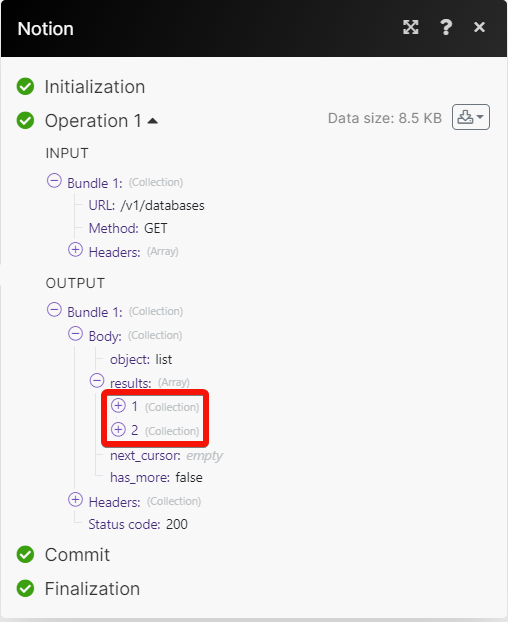Notion¶
With the Notion modules in Ibexa Connect, you can:
-
watch, retrieve, create and update the database item
-
watch, create, update, search, and retrieve database or pages
-
watch, list, and append page content
To get started with the Notion, create an account at notion.so/signup.
Note
The user account must have admin permission to create a connection.
Note
The module dialog fields that are displayed in bold (in the Ibexa Connectscenario , not in this documentation article) are mandatory!
Connect Notion with Ibexa Connect¶
Ibexa Connect provides two ways to connect the Notion app:
Establish Notion Internal Connection¶
To connect the Notion app with the Ibexa Connect:
-
Log in to your Notion account.
-
Click Settings & Members > Integrations > Develop your own integrations. or Alternatively, you can go to https://www.notion.so/my-integrations.

-
Click New Integration > Copy internal integration token.
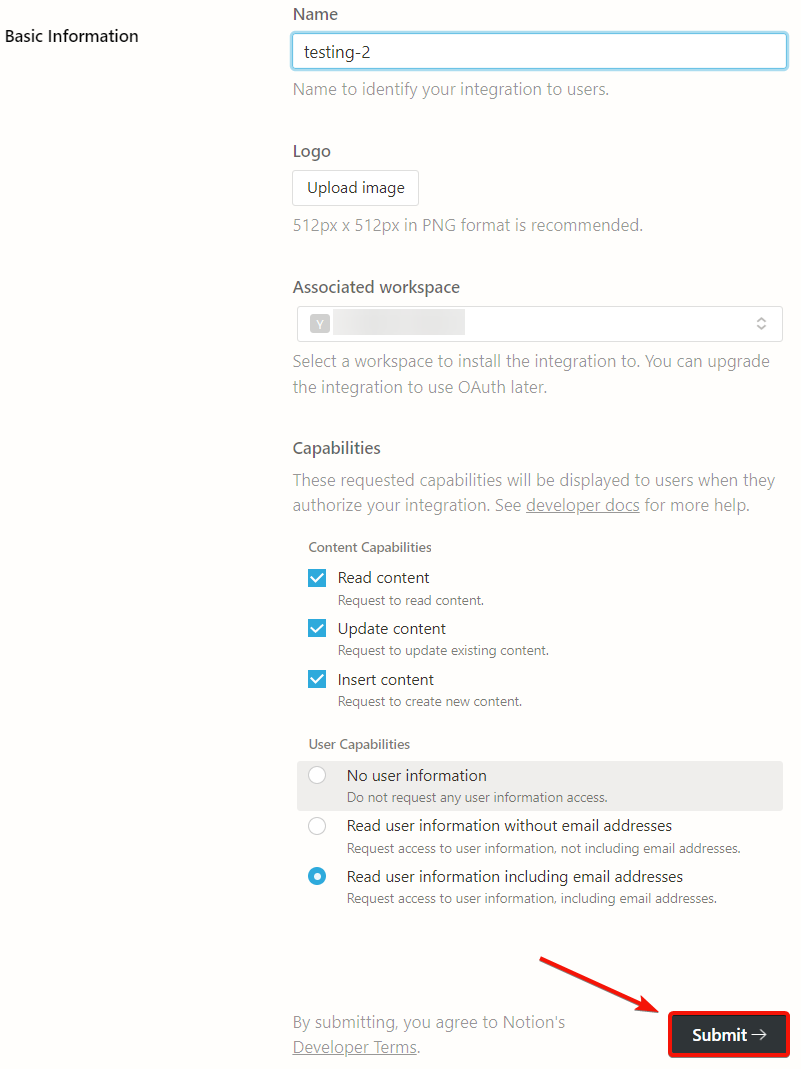
-
Copy the Internal Integration Token to your clipboard.

-
Log in to your Ibexa Connect and add a module from the Notion into a Ibexa Connect scenario.
-
Click Add next to the Connection field.
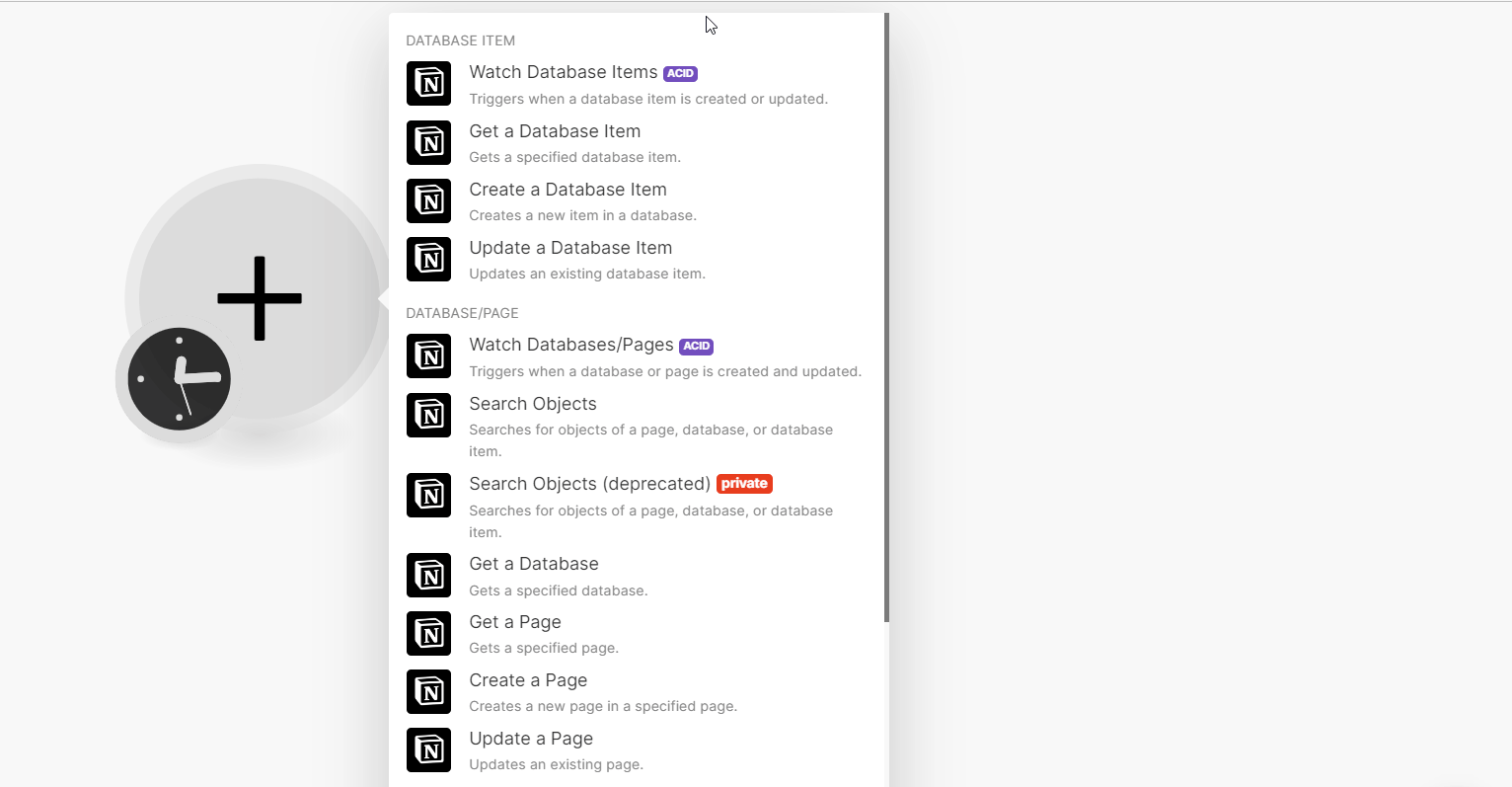
-
In the Connection name field, enter a name for the connection.
-
In the Internal Integration Token field, enter the details copied in step 3 and click Save.
You have successfully connected the Notion app with Ibexa Connect and can now build scenarios.
If the databases are visible in the Database ID > Search field, follow the instructions in Add Databases to be visible in the Ibexa Connect to add them to Search field.
Establish Notion Public Connection¶
To establish a Notion public connection:
-
Log in to your Ibexa Connect account and add a module from the Notion into a Ibexa Connect scenario.
-
Click Add next to the Connection field.

-
In the Connection name field, enter a name for the connection. Click Save.
-
Click Select pages to grant access to the Ibexa Connect for accessing your Notion account.
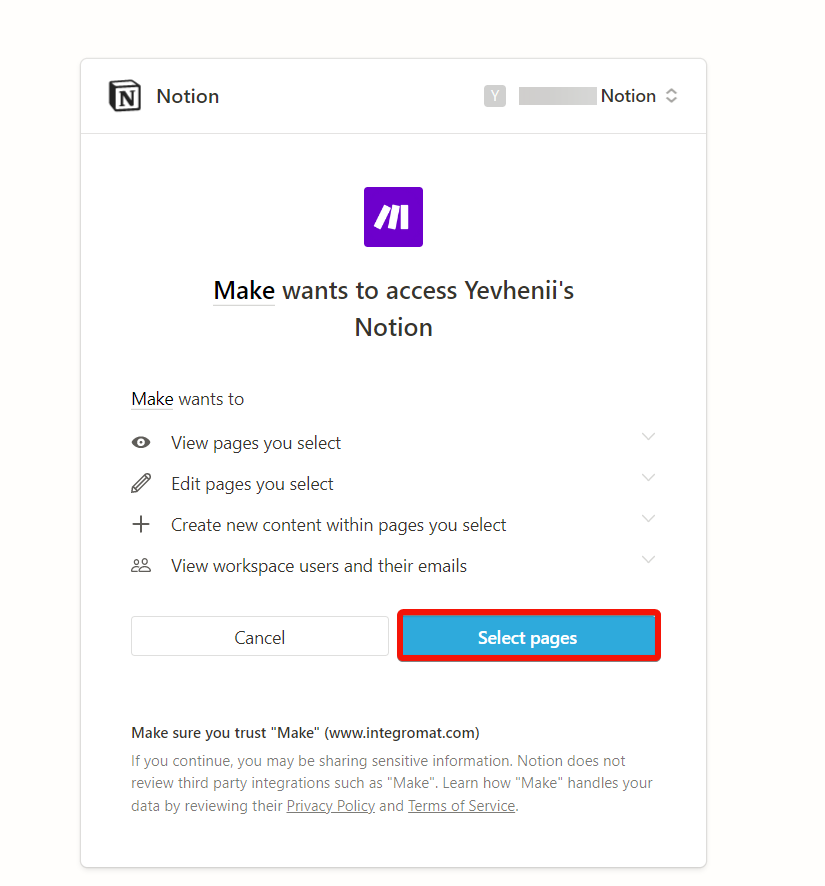
-
Select the pages and confirm the access by clicking Allow access.

You have successfully connected the Notion app with Ibexa Connect and can now build scenarios.
Add Databases to be visible in the Ibexa Connect¶
For the Notion internal connection, by default, the databases do not appear in the Database ID field > Search option. You need to manually add them to the Ibexa Connect app from your Notion account.
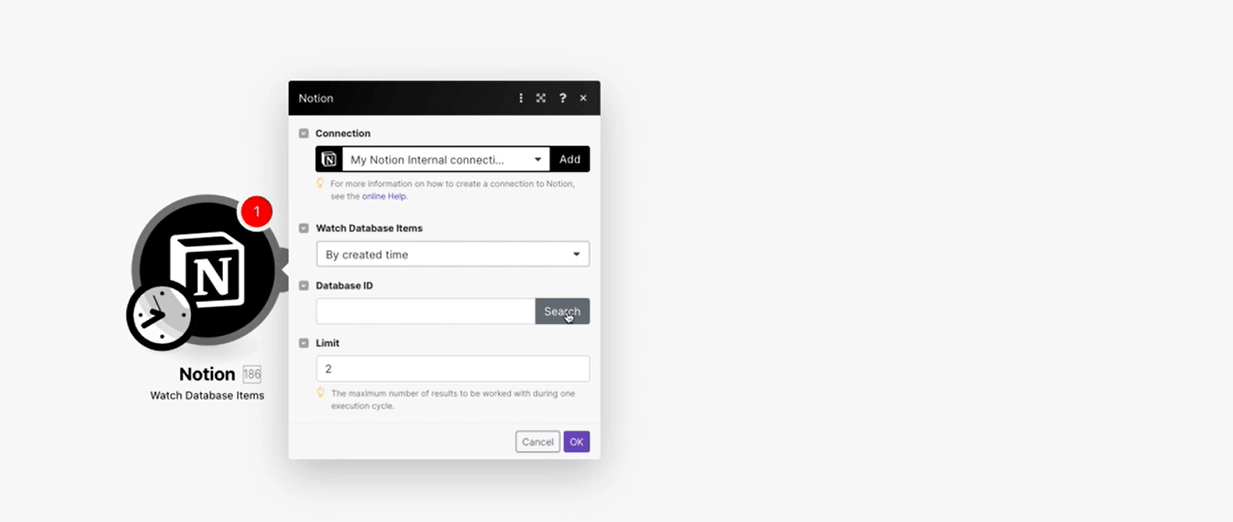
To add databases from your Notion account to Ibexa Connect app:
-
Log in to your Notion account.
-
Navigate to the database you want to add to Ibexa Connect, click Share > Invite.

-
Select the workspace and click Invite. You can multiple databases.
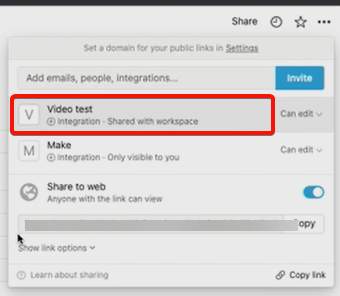
The databases are successfully shared and you can see them in the Database ID > Search field.

Retrieve added databases and pages after establishing the connection¶
Note
If new pages were added to the Notion account, you must revoke the connection in your Notion account and then in the Ibexa Connect to retrieve the added databases or pages.
To retrieve the newly added databases and pages :
-
Log in to your Notion account.
-
Click Settings & Members > Integrations > ... > Disconnect Ibexa Connect.

-
Go to Ibexa Connect > Connections > Search for Notion connection > Reauthorize.
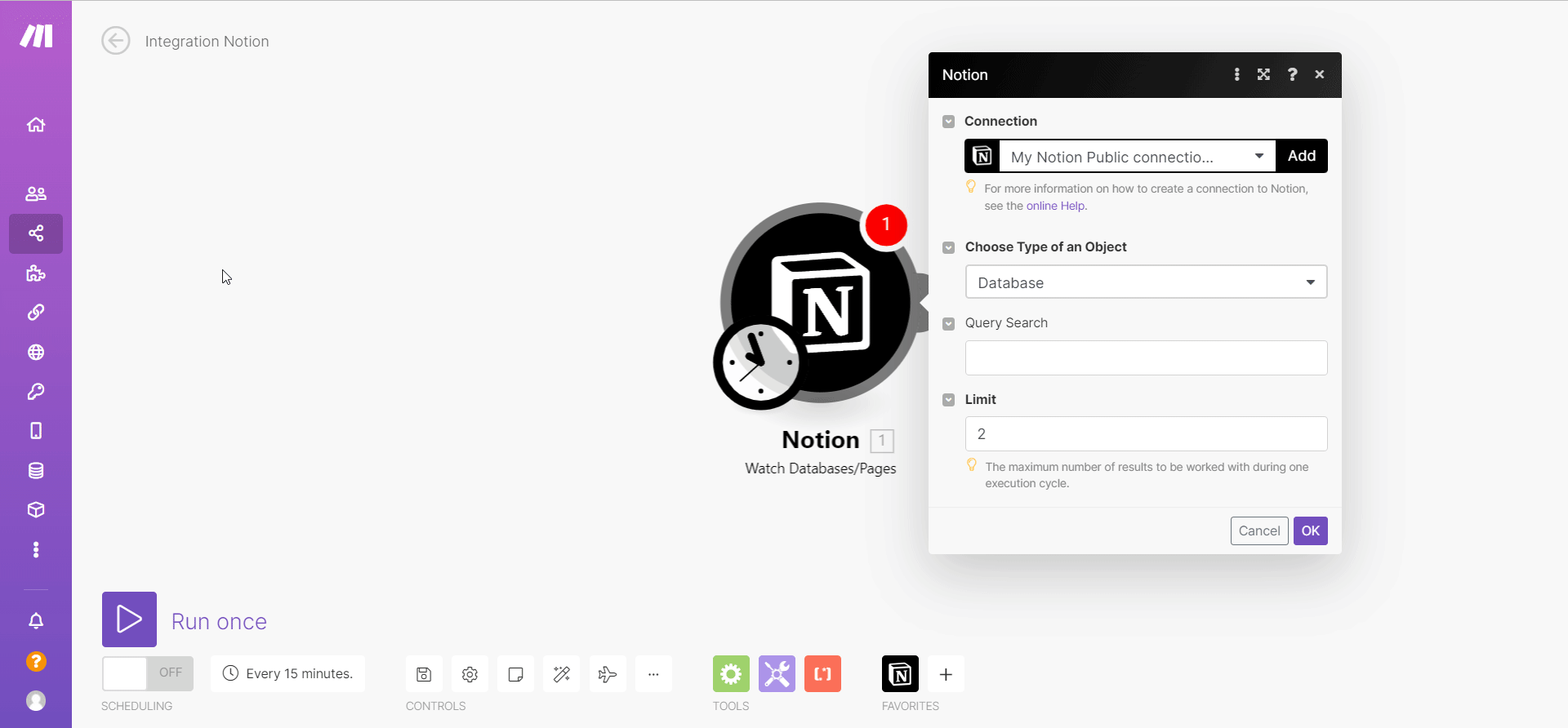
You can see the newly added databases and pages in your Notion Ibexa Connect connection.
Database Item¶
You can watch, create, update, and retrieve the database items using the following modules.
Watch Database Items¶
Triggers when a database item is created or updated.
Watch Database Items |
Select or map the option to watch the database items:
|
Database ID |
Enter (map) the Database ID whose items you want to watch. Alternatively, you can enter query to search a database. |
Limit |
Set the maximum number of database items Ibexa Connect should return during one execution cycle. The default value is 2. |
Get a Database Item¶
Gets a specified database item.
Get a Database Item |
Select a method:
|
Database Item ID |
Enter (map) the Database Item ID whose details you want to retrieve. |
Database ID |
Select the Database ID:
|
Database Item ID |
Select or map a Database Item ID to retrieve a database item. |
Create a Database Item¶
Creates a new item in a database.
Enter Database ID |
Select the option to choose the Database ID:
|
||||||
Database ID |
Enter (map) the Database ID for which you want to create the database item. Alternatively, you can search for a Database ID. |
||||||
Fields |
Enter (map) the details of the fields. For more information, see the property schema objects.
|
Update a Database Item¶
Updates an existing database item.
Enter a Database ID |
Select the option to choose the Database ID:
|
||||||
Database ID |
Enter (map) the Database ID whose item details you want to update. |
||||||
Page ID |
Enter (map) the Page ID whose details you want to update. |
||||||
Fields |
Enter (map) the details of the fields. For more information, see the property schema objects.
|
Database/Page¶
You can watch, create, update, and search the databases or pages using the following modules.
Watch Databases/Pages¶
Triggers when a database or page is created and updated.
Choose Type of an Object |
Select or map the option to watch the objects:
|
Query Search |
Enter a keyword or phrase to watch the objects that match the specified query. |
Limit |
Set the maximum number of objects Ibexa Connect will return during one execution cycle. The default value is 2. |
Search Objects¶
Searches for objects of a page, database, or database item.
Search Objects |
Select or map the option to search the objects:
|
Database ID |
Select or map the Database ID whose objects you want to search. |
Query Search |
Enter a keyword or phrase to search the objects that match the specified query. |
Sort |
Select the order of sorting for the objects.
|
Limit |
Set the maximum number of objects Ibexa Connect will return during one execution cycle. The default value is 10. |
Get a Database¶
Gets a specified database.
Searches for objects of a page, database, or database item.
| Database ID | Enter (map) the Database ID whose details you want to retrieve. Alternatively, you can search for a Database ID. |
Get a Page¶
Gets a specified page.
| Page ID | Select or map the Page ID whose details you want to retrieve. |
Create a Page¶
Creates a new page on a specified page.
Create a Page |
Select or map a location where you want to create a page:
|
||
Parent Page ID |
Select or map a Parent Page ID to which this page belongs. |
||
Get a Database Item |
Select a method to retrieve a database item:
|
||
Database Item ID |
Enter (map) a Database Item ID whose page you want to create. |
||
Database ID |
Select a Database ID. For example, |
||
Database Item ID |
Select or map a Database Item ID whose page you want to create. |
||
Title |
Enter (map) the page name. |
||
Content Objects |
Enter (map) the details of content objects:
|
||
Emoji Icon |
Enter (map) an emoji icon for the content object. |
||
Cover URL link |
Enter (map) the URL address of the cover to be used for the content object. |
Update a Page¶
Updates an existing page.
| Page ID | Select or map the Page ID whose details you want to update. |
| Title | Enter (map) a new name for the page. |
| Emoji Icon | Enter (map) an emoji for the content object. |
| Cover URL link | Enter (map) the URL address of the cover to be used for the content object. |
| Archived | Select whether this page is archived. |
Page Content¶
You can watch, list, and append the page content using the following modules.
Watch Page Content¶
Triggers when page content is created.
| Page ID | Select or map the Page ID whose content you want to watch. |
| Limit | Set the maximum number of page contents Ibexa Connect will return during one execution cycle. The default value is 2 |
List Page Contents¶
Retrieves a list of page contents.
| Page ID | Select or map the Page ID whose content you want to list. |
| Limit | Set the maximum number of page contents Ibexa Connect will return during one execution cycle. The default value is 10. |
Append a Page Content¶
Appends a new page content.
Page ID |
Select or map the Page ID whose content you want to append. |
||||
Content Objects |
Enter (map) the details of content objects:
|
Other¶
You can call APIs using the following module.
Make an API Call¶
Performs an arbitrary authorized API call.
URL |
Enter a path relative to For the list of available endpoints, refer to the Notion API Documentation. |
Method |
Select the HTTP method you want to use: GET to retrieve information for an entry. POST to create a new entry. PUT to update/replace an existing entry. PATCH to make a partial entry update. DELETE to delete an entry. |
Headers |
Enter the desired request headers. You don't have to add authorization headers; we already did that for you. |
Query String |
Enter the request query string. |
Body |
Enter the body content for your API call. |
Example of Use - List Databases¶
The following API call returns all the databases from your Notion account:
URL:
/v1/databases
Method:
GET
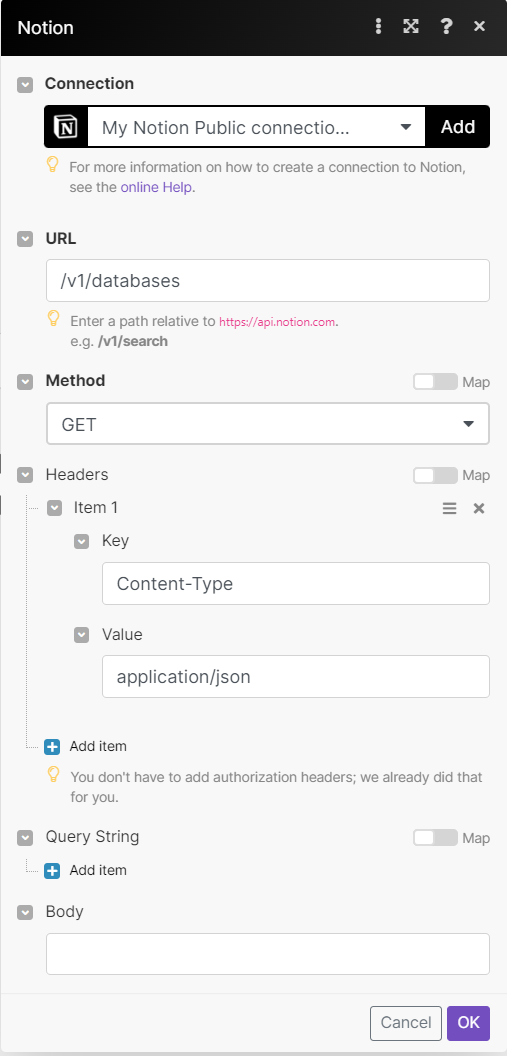
Matches of the search can be found in the module's Output under Bundle > Body > results.
In our example, 2 databases were returned:
